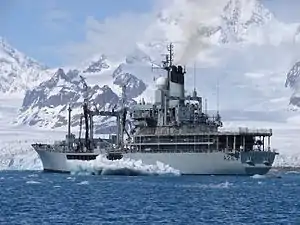RFA Grey Rover (A269)
RFA Grey Rover (A269) was a Rover class small fleet tanker of the Royal Fleet Auxiliary. She was decommissioned in 2006.
 The RFA Grey Rover around the coast of South Georgia Falkland Islands, October 2005. | |
| History | |
|---|---|
| Ordered: | January 1968 |
| Builder: | Swan Hunter |
| Yard number: | 7 |
| Laid down: | 28 February 1968 |
| Launched: | 17 April 1969 |
| Commissioned: | 10 March 1970 |
| Decommissioned: | 24 February 2006 |
| Identification: | IMO number: 6923163 |
| Fate: | Scrapped |
| General characteristics | |
| Class and type: | Rover class |
| Displacement: |
|
| Length: | 461 ft (140.5 m) |
| Beam: | 63 ft (19.2 m) |
| Draught: | 24 ft (7.3 m) |
| Propulsion: |
|
| Speed: | 19 knots (35 km/h) |
| Range: | 15,000 miles (24,000 km) at 15 knots (28 km/h) |
| Capacity: | 3,000 m³ of fuel |
| Complement: |
|
| Sensors and processing systems: | Sperry Marine Visionmaster radars and ECDIS. 1690 I band navigation radars |
| Electronic warfare & decoys: |
|
| Armament: |
|
| Aircraft carried: | Helicopter deck but no hangar |
Launch and commissioning
Grey Rover was launched at the Swan Hunter yard, Hebburn on Tyne, on 17 April 1969. The Lady Sponsor was Lady Parker, the wife of Vice Admiral Sir John Parker KBE, CB, DSC who was Flag Officer Medway. She was completed on 10 April 1970 and accepted into service 3-months later than planned.
Operational history
1970-1980
In September 1970, Grey Rover took over from Black Ranger as FOST tanker.
In July 1973, she was involved in a collision with the Canadian Submarine HMCS Okanagan resulting in the need to dry dock in Govan for repairs.[2][3]
Between 17 June 1976 and 22 June 1976 she stood off the Lebanon to evacuate British nationals along with RFA Stromness and the frigates HMS Exmouth and HMS Mermaid.[4]
1981-1990
During Operation Corporate (the Falklands War), Grey Rover was the only operational RFA tanker which remained in UK waters. She carried out RAS trials with STUFT ships en route to the Falkland Islands in the SW Approaches to the English Channel whilst herself based at Portland. The smallest vessel worked with was the trawler F/V Farnella and the largest was the liner RMS Queen Elizabeth 2.[5]
1991-2000
In January 1994, Grey Rover berthed at Cape Town, South Africa in company with HMS Norfolk for a five day visit. Both ships were open to the public and 53,000 visitors we received on board both ships.
Grey Rover's last refit was 15 June - 27 November 1998 which extended her service life into the 21st century.
2001-2006
On 2 February 2006, while supporting the Type 42 destroyer HMS Southampton in the Caribbean as part of Atlantic Patrol Task (North), Grey Rover was involved in the boarding of merchant vessel M/V Rampage and the seizure of 3.5t of cocaine with an estimated street value of £350 million.[6]
In November 2004, the Parliamentary Under-Secretary of State for Defence Procurement Lord Bach announced that Grey Rover would have a decommissioning date of 2007. She paid off early on 15 March 2006 and was towed to Canada Dock, Liverpool for scrapping.[7][8][9] Her scrapping was recorded in a time-lapse video.[10]
References
- http://www.royalnavy.mod.uk/The-Fleet/Royal-Fleet-Auxiliary/Tankers/RFA-Black-Rover
- http://historicalrfa.org/the-adventures-of-a-conway-lad-on-rfa-grey-rover-1973-74
- https://www.rcnhistory.org/lapierre/lapierre-okanagan-greyrover-1973.htm
- http://www.historicalrfa.org/rfa-grey-rover-ships-details
- QE2 in the Falklands War
- UK ships seize £350m drugs cache
- Hansard 1 November 2004
- Hansard 12 November 2004
- Leavesley International
External links
- RFA Grey Rover - Ships Nostalgia
- RFA Grey Rover - Flickr
- UK ships seize £350m drugs cache